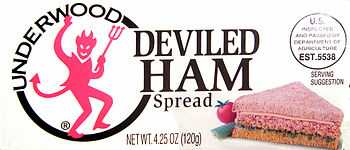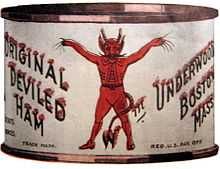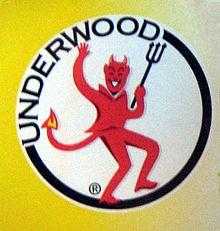William Underwood Company
The William Underwood Company, founded in 1822, was an American food company best known for its flagship product, Underwood Deviled Ham, a canned meat spread. The company also had a key role in time-temperature research done at the Massachusetts Institute of Technology (MIT) from 1895 to 1896, which would lead to the development of food science and technology as a profession.

Founding and growth
The company was established by its founder William Underwood (1787–1864) in 1822 in Boston, Massachusetts,[1] as a condiment company using glass packing techniques. Among the condiments and other items glass packed were mustard, ketchup of various kinds, many types of pickled vegetables, and cranberries,[1] primarily focusing on mustards and pickling.[2] By 1836, Underwood shifted his packing from glass to steel cans coated with tin on the inside because glassmakers in the Boston area could not keep up with product demands from the canning company.[1]
Underwood's canned foods proved valuable to settlers during the Manifest Destiny period of 1840–60.[1] Additionally, Underwood sold numerous canned foods to Union troops during the American Civil War of 1861–65.[1] The amount of products canned increased to include seafood products, such as lobster, oyster, and mackerel.[1] William Underwood died in 1864,[1] the same year that William Lyman Underwood, one of his three grandsons, was born. Underwood's son, William James Underwood, would head the business as new retort technology continued to be developed for use.
Involvement with MIT
From its beginning, the company encountered the problem of cans swelling,[3] causing a great deal of product loss. In late 1895, William Lyman Underwood, a grandson of the founder, asked MIT for assistance with this problem.[4][5]
Underwood approached William Thompson Sedgwick, the chair of the Biology department at MIT about the concerns he had with product swells and explosion of cans of clams.[4] Sedgwick conferred with his assistant, Samuel Cate Prescott,[4] and from late 1895 to late 1896, Prescott and Underwood worked on the problem every afternoon, focusing on canned clams.[6] They discovered that the clams contained heat-resistant bacterial spores that were able to survive the processing; then they learned that these spores' presence depended on the clams' living environment, and finally that these spores would be killed if processed at 250°F (121°C) for 10 minutes in a retort.[7]
These studies prompted the similar research of canned lobster, sardines, peas, tomatoes, corn, and spinach.[8] Prescott and Underwood's work was first published in late 1897.[8] This research, which was never patented,[9] proved beneficial to the William Underwood Company, the canning industry, the food industry, and food technology itself.[10][11]
In the mid-1950s, outgoing company president W. Durant brought new president George Seybolt to MIT to meet Prescott.[12] At the Institute of Food Technologists Northeast Section (Maine, Massachusetts, New Hampshire, Rhode Island, and Vermont) meeting at Watertown, Massachusetts, in April 1961, the William Underwood Company dedicated a new laboratory in honor of both Prescott and William Lyman Underwood.[13] Following Prescott's death in 1962, the William Underwood Company created the Underwood Prescott Memorial Lectureship in memory of both Underwood and Prescott.[14] This Lectureship would run until 1982. In 1969, Seybolt donated USD 600,000 to MIT to create the Underwood Professorship,[14] followed up with an Underwood Prescott Professorship in 1972.[15] Three MIT faculty have held this professorship since its inception: Samuel A. Goldblith,[15] Gerald N. Wogan,[15] and since 1996, Steven R. Tannenbaum.[16][17]
Acquisitions and sale
Expansion in 1960s
Underwood acquired the Burnham & Morrill (B&M) Company of Portland, Maine, in 1965.[18] B&M had actually purchased canned clams and tomatoes from Underwood in the late 1860s for resale before producing these products on its own. Baked beans were the best known product that B&M started producing, which it started doing in the 1920s with its Brick Oven Baked Beans.[18] Piermont Foods, a food company in Montreal, Canada, was acquired in 1968[18] in order for Underwood to sell its products north of the border.
Sale of Underwood to PET
Underwood, which up to this point had been privately owned by the Underwood family, was sold to PET in 1982,[19] and B&M's Westwood, Massachusetts, facility was closed. Included in this was B&M Foods as part of the sale. Thirteen years later, the Pillsbury Company acquired PET Inc.[19] and began a modernization process that included warehousing, production, and processing. B&G Foods of New York, New York, acquired the Underwood foods, including the line of Underwood's canned meat spreads,[20] sardines, B&M, and Accent,[21] in 1999.[18]
Deviled ham and devil logo


Deviled ham was created in 1868[1] as a mixture of ground ham with seasonings; deviling would also be done with other meat and seafood products. This included turkey, lobster, chicken, and tongue. Deviling consists of adding such spices as hot sauce, cayenne pepper, Dijon mustard, or chopped chili peppers. Deviled eggs are one well-known example of this process. The devil logo was trademarked in 1870 and it is the oldest food trademark still in use in the United States.[1] The red devil that debuted in 1895[1] and started as a demonic figure evolved into a much friendlier version when compared to the original.
The older version, in use during the first half of the 20th century, can be seen in many old magazine advertisements, such as one from Woman's Home Companion, August 1921.[22] It lacks the pitchfork and smile of the modern version, but has long fingernails or claws not found in the modern version. The barbed tail is in the shape of the letter W, and along with the lower-case M to the right of the devil forms the abbreviation "Wm.", for William, as in William Underwood. The lettering in the logo and on the can are also spouting small flames, reinforcing the spicy devil concept. In 2008, B&G Foods updated the devil logo by adding color to the previously all-red image. The pitchfork became black, and small amounts of yellow were added in the tail and horns, along with shading to add depth.
The devil logo has appeared on Underwood products that are not deviled as part of the overall brand identity, such as sardines and chicken spread.[1]
Other companies have made deviled ham products. In 1895, at least seven other companies produced their own versions of a deviled ham, among them Armour and Company, and in 1900 Libby's entered the market with its own deviled ham product.[23]
In 1906, the Massachusetts Board of Health banned all deviled meats, except Underwood's, from sale in Massachusetts.[24] The National Billposters' Association, based in Chicago, center of America's meat packing industry at the time, then banned its members from posting bills with devil images on them.[25]
In popular culture
Underwood deviled ham, although not one of the most well-known food products, does appear in American popular culture from time to time. By doing so, this shows that Underwood's most well-known product remains in people's minds, and beyond that these cultural references remind the consumers of these cultural products of deviled ham.
- Deviled ham plays a small role in The Poisonwood Bible by Barbara Kingsolver, appearing in the beginning (p. 13), middle, and end, as an example of a completely inappropriate item that the family thought they would need in Africa.
- One of the main characters, Davy, in Peace Like a River by Leif Enger, steals "tins of sardines and deviled ham" from a store near the end of the story (p. 296).
- In The Virginian (Owen Wister, 1902) there is this reference at the opening of chapter 4: "Sardines were called for, and potted chicken, and devilled ham.... So through my eyes half closed I watched the sale of these tins, and grew familiar with the ham's inevitable trademark--that label with the devil and his horns and hoofs and tail very pronounced, all colored a sultry prodigious scarlet."[26]
- The William Underwood Company is mentioned in the "Civil War Tech" episode (#342) of the TV series Modern Marvels, near the end of the episode during the segment on canned food.
- Marge Simpson of The Simpsons buys a can in Episode 2F21 (#623), "The Springfield Connection", where she is rebelling against her boring housewife existence. When grocery shopping, she says, "Strange, regular ham doesn't thrill me anymore. Hmmph. I'm crossing over to deviled ham."
- In the Real Ghostbusters episode "The Devil To Pay," upon beating a minor demon's game show challenges, the team is sent to Tahiti, all expenses paid, and the prize package includes three tons of deviled ham.
- In the episode The Devil is in the Details... and in the Upstairs Bedroom of the USA Network show Psych, when a dead character is claimed to have been possessed by the devil, Shawn shows Gus a sketch of the William Underwood Company devil logo, claiming it is a police sketch of the suspect, "last seen at the local canned ham factory."
- In the TV series White Collar (also on the USA network), FBI agent Peter Burke often eats deviled ham sandwiches on stakeouts.[27]
- Underwood Deviled Ham makes an appearance in Lisa Birnbach's 1980 book of WASP living, The Official Preppy Handbook. It is mentioned as item #2 in the article "Off The Wagon: The Tailgate Picnic."
References
- ↑ 1.0 1.1 1.2 1.3 1.4 1.5 1.6 1.7 1.8 1.9 1.10 Underwood History
- ↑ Shaw, F. H. (1957). The history of the William Underwood Company, 1821-1954. Unpublished doctoral dissertation, Harvard University. (HU 90.7263, film 6209.) Pp. 13-14.
- ↑ Goldblith, S.A. (1993). Pioneers in Food Science, Volume 1: Samuel Cate Prescott - M.I.T. Dean and Pioneer Food Technologist. Trumball, CT: Food and Nutrition Press. P. 21.
- ↑ 4.0 4.1 4.2 Goldblith, p. 21.
- ↑ MIT Entrepreneurship Center - Technology Leadership
- ↑ Goldblith, pp. 21-2.
- ↑ Goldblith, pp. 22-3.
- ↑ 8.0 8.1 Goldblith, p. 22
- ↑ Goldblith, p. 24
- ↑ Goldblith, p. 28
- ↑ MIT Libraries, Institute Archives and Special Collections, History of the Department of Biology
- ↑ Goldblith, p. 125
- ↑ Goldblith, pp. 125-6.
- ↑ 14.0 14.1 Goldblith, p. 128
- ↑ 15.0 15.1 15.2 Goldblith, p. 130.
- ↑ MIT Department of Biological Engineering
- ↑ MIT Reports to the President 1996-97, Division of Toxicology
- ↑ 18.0 18.1 18.2 18.3 B&M History
- ↑ 19.0 19.1 B&G History at FundingUniverse
- ↑ Underwood Meat Spreads
- ↑ B&G: "Get to Know Our Family", AccentFlavor.com
- ↑ Woman's Home Companion. (Aug, 1921). P. 65.
- ↑ Shaw, pp. 93–94.
- ↑ Shaw, pp. 95–96
- ↑ Shaw, p. 96
- ↑ Wister's The Virginian at Project Gutenberg
- ↑ 'White Collar': Tiffani Thiessen on Elizabeth's 'soft spot' for Neal, chances of a baby for the Burkes, and her dream guest star. (Hint: Reunion!)
Further reading
- Diablitos Underwood, a Venezuelan blog entry about Underwood Deviled Ham in Venezuela from the blog Cuando Era Chamo.
- The Encyclopedia Americana. (1918). pp. 506 – 509. "Canning and Preserving History"
- Powers, J.J. "The Food Industry Contribution: Preeminence in Science and in Application." A Century of Food Science. (2000). Institute of Food Technologists: Chicago. pp. 17–18.
- Wanucha, Genevieve. "Two Happy Clams: The Friendship that Forged Food Science". Food Technology. November 2009. p. 88.